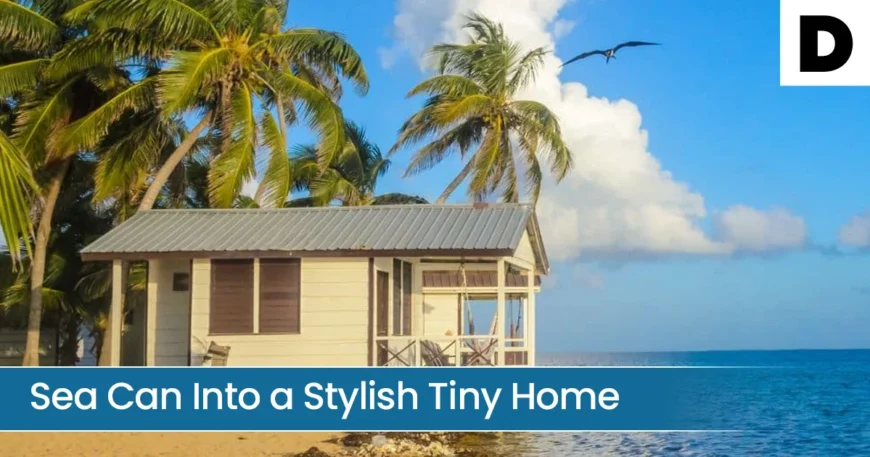In the era of sustainability, prioritizing the reuse and repurposing of materials is fundamental for its ability to reduce waste and save resources. Building a traditional house from scratch is a time and money-consuming process. This creates monetary issues for the consumer and produces a lot of waste. Every year, construction, renovation, and demolition of housing structures create nearly 4 million tonnes of waste in the country. In this case, discarded sea cans, or shipping containers, make a perfect eco-friendly housing solution. Check out the tiny houses built from shipping containers, they are durable, and modular units have many benefits over traditional construction methods. It is an affordable and eco-friendly solution to conventional housing. This blog will explore the process, advantages, and essential factors to consider when converting a sea can into a comfortable and practical tiny home.
Big Advantages of Tiny Living: The Perks of a Shipping Container Home
Recycling is good for the environment
Recycling shipping containers into tiny homes is the most eco-friendly way of building a home.
- Shipping containers are resilient and usually sit idle at ports after they have outlived their service. Transforming these shipping containers into functioning tiny homes will ensure that they don’t end up in a landfill or rust away.
- Traditional homes use a great deal of raw materials and construction materials, producing more waste. In contrast, shipping containers require fewer materials, thus reducing construction waste.
Modified sea cans reduce construction time
Shipping containers remodeled into tiny homes save construction materials and are a great alternative to save time. They are pre-fabricated, which can be assembled easily and save time and resources compared to traditional homes. Additionally, because they are so durable, there is no need for additional structural support like with traditional building materials such as wood or brick.
Security of modified sea cans
Shipping containers are also incredibly secure compared to traditional building materials. They are designed to withstand extreme weather conditions, and their walls are thick enough to prevent break-ins. Additionally, their doors can be locked inside and out, making them even more secure than traditional homes.
Shipping container tiny houses offer many benefits over traditional homes, including being eco-friendly, faster construction times, and increased security. They provide an affordable housing option that is both sustainable and safe for those looking to downsize or live off the grid.
How to Convert a Sea Can into a Tiny Home
Planning & Design
The first step towards building a cozy house is proper planning and developing a basic design for implementation. Draft a detailed floor plan for building a home from a shipping container. Incorporate multi-use furniture for effective use of available space. Design should be created keeping in mind factors like natural light, space available, and the number of people living in it.
Choosing the Right Container
The next step in the home-making process is to choose the right container according to your needs and comfort. Not all sea cans are the same. You should choose a well-maintained unit, which has only been used much and is in excellent condition.
Preparing the Structure
These sea cans can contain chemicals or harmful substances; hence next step should involve preparing the structure and thoroughly cleaning the sea cans.
- Cleaning – Remove all the chemicals or harmful substances that may be present in the sea can.
- Structural Modifications – Structural modifications are necessary to include frameworks for doors and windows. Cut openings for doors and windows while reinforcing the frame as needed.
Insulation & Climate Control
In countries with extreme climates, proper insulation will ensure a comfortable indoor temperature year-round. Some of the trending choices involve the following:
- Spray foam insulation (superior thermal efficiency)
- Fiberglass or wool insulation
- Sustainable options like recycled denim
Plumbing & Electrical Setup
Decide whether your home will connect to public utilities or be self-sufficient. Key considerations include:
- Electrical wiring, solar panels, or a backup generator
- Water tanks, greywater recycling, and septic solutions
Interior Design & Furnishing
Maximize limited space by incorporating:
- Lofted beds and foldable furniture
- Built-in storage solutions
- Large windows create a bright and open feel
Exterior Finishing Touches
Enhance the container’s appearance and durability with:
- A fresh coat of weather-resistant paint
- Cladding materials like wood or corrugated metal
- A rooftop deck or small patio for extra living space
Decorate And Move In
Once all these steps are completed successfully, it’s time for some fun stuff – decorating & moving in! Now’s when all those Pinterest boards come in handy – fill up those empty spaces with furniture pieces & artwork pieces found online/in stores nearby & make this space truly yours! Don’t forget about finishing touches like curtains/rugs/pillows, etc, which help bring everything together nicely too
Challenges & Considerations
While sea can homes offer many benefits, they also come with challenges:
- Building Codes & Permits – Check local regulations before starting your project.
- Temperature Control – Proper insulation is essential to prevent extreme heat or cold.
- Structural Integrity – Any modifications, like cutting into the steel frame, may require reinforcements.
Conclusion
Turning a sea can into a tiny home is an exciting and sustainable way to create a unique living space. Whether you’re looking for an off-grid retreat or a full-time residence, these homes offer endless possibilities. With careful planning and execution, you can transform a simple shipping container into a stylish and functional home.



